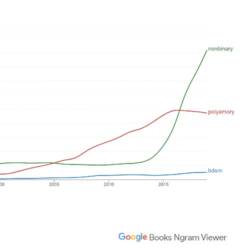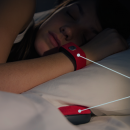An Exploration in How to Sleep Together Remotely
Consent and privacy can’t be overlooked when it comes to intimate tech.

The lack of physical intimacy in long-distance relationships is a real problem.
Usually, we see companies tackle this issue by creating ways that we can have sex remotely—particularly through products like interactive sex toys.
What’s missing is often other forms of intimacy beyond sex, like sleeping next to each other.
This is what Danae Tapia, founder of The Digital Witchcraft Institute, discovered when the pandemic hit in 2020.
“Most of the countries had a full lockdown… you couldn’t go to someone else’s place and stay there because you could get the virus and there were all these restrictions,” she explains.
“It was also quite sad because we were acknowledging how painful it was to be distant.”
Tapia started exploring sleep technologies while speculating about an app that could allow people to virtually “sleep together” despite strict lockdown regulations or any other reason people may be apart.
“We started to do this speculation about a possible app that could replicate the act of sleeping with someone. Not really having sex, but sleeping,” she says.
Sleeping with someone requires trust—and this must be considered in product development
Much like sex, sleeping with someone is an intimate act of trust. Arguably sleeping more so, because of the vulnerability of your physical state.
When you’re sleeping, your body is exposed and you’ve given up a sense of control. In order to truly let yourself rest, you need to have confidence in your safety.
That’s why, according to Tapia, any technologies involved with your sleep must include two key components: Consent and privacy.
“You’re actually in an act of deep trust, of deep consent… it’s an essential part of sleeping with someone,” she says.
If you’re going to sleep “together” with someone else remotely, this should be an opt-in experience. You should know how much access to yourself you’re revealing. Can they see you? Hear you? Feel your heart beating?
Everyone involved should also be ok with the uncertainties that come with being unconscious around another human. This could be anything from letting out an innocent snort to unknowingly voicing your desires.
Consequently, being aware of what data is being collected and who that data is being shared with is essential. This includes the people involved with the remote sleeping experience, as well as the underlying company developing the product and any third-party services they may be partnered with.
Creating a new, remote way to sleep with another person comes with challenges
When presenting the concept for her app at Touchy Feel Tech’s Sex Tech Talk Show, Tapia also touched on challenges that developing technology like this could present.
Physical distance was the first, as that was what inspired the app’s creation. Closely tied to physical distance are potential difficulties with varying timezones and internet accessibility, which are amplified the more people are involved.
Then there’s the potential issue of poor communication, which Tapia says is connected to consent. In her Sex Tech Talk Show presentation, Tapia gave the example of witchcraft and someone creating a spell to control someone else’s sleep without their knowledge:
“How are we going to recreate this idea of two people wanting to sleep together and avoid this tendency… to control another person without consent? That’s the challenge for me, how are we going to keep these two people communicating?”
What future sleep technologies could look like
As of today, Tapia’s speculative app is still only a concept. She’s not certain how sleep technologies will advance, but she seems confident that there’s a place for them in the sex tech industry:
“Maybe using advanced tech to see how to collect or promote or advance these desires that emerge in the oneiric world. Maybe lucid dreaming and desire—and sex, of course.”

















